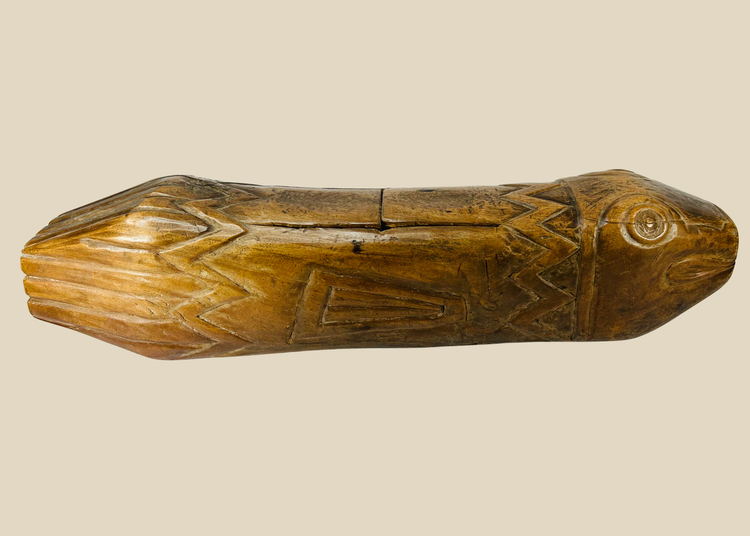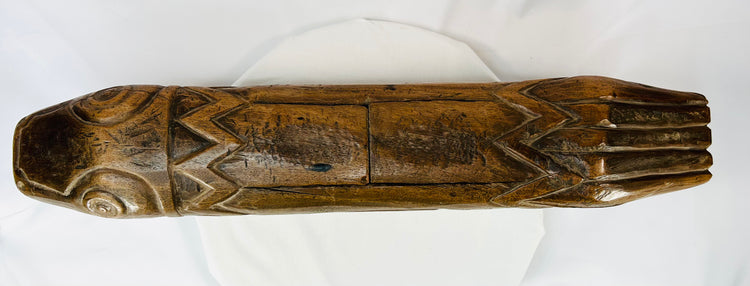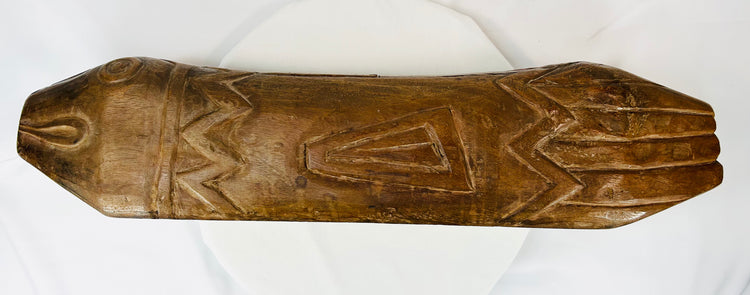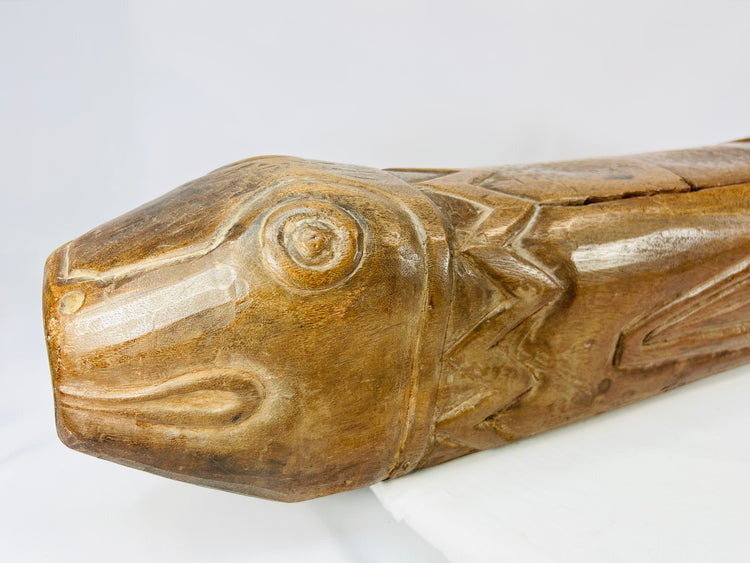Tribal Carved Wooden Fish Drum or Ceremonial Container | Melanesia | Circa 19th–Early 20th Century
Description
More
Less
Historical Context & Origin
Region: Papua New Guinea or Solomon Islands (Melanesia)
Material: Hand-carved hardwood
Period: 19th–Early 20th Century
Description
An exceptional hand-carved wooden ceremonial object in the stylized form of a fish, crafted by Melanesian tribal artisans. The elongated body is carved from a single block of dense hardwood and decorated with deeply incised zigzag and geometric patterns—motifs symbolizing waves, energy, and life. The head features pronounced circular eyes and an open mouth, evoking the spiritual essence of water-borne creatures revered in Oceanic culture.
This hollow form likely served as a slit drum or ritual container, resonating with symbolic and sonic purpose. Its smooth, time-worn surface exhibits a rich patina, bearing witness to ceremonial handling and centuries of cultural continuity.
Features
- Hand-carved hardwood depicting a fish form with incised tribal patterns
- Zigzag and triangular motifs representing movement and energy
- Hollow interior for resonance or ritual storage
- Warm natural patina with traces of age and use
- From a private ethnographic collection
Cultural Significance
Fish imagery in Melanesian art symbolizes transformation, abundance, and ancestral protection. Carved forms such as this were integral to ritual soundmaking and spiritual communication. Whether sounded as a drum or used as a ceremonial vessel, this piece embodies the union of artistic craftsmanship and sacred expression found in Oceanic traditions.
Condition
Excellent antique condition with surface wear, natural age cracking, and deep patina consistent with ceremonial use. Structurally stable and unrestored.
Dimensions (Approximate)
Length: 25 in
Width: 5 in
Height: 6 in
Age
Circa 19th–Early 20th Century
Learn More & Explore
Explore Melanesian carvings, drums, and ritual art in The Menil Collection’s Pacific Islands Gallery
Explore authentic ethnographic artifacts from cultures around the world View Ethnographic Relics
Description
Historical Context & Origin
Region: Papua New Guinea or Solomon Islands (Melanesia)
Material: Hand-carved hardwood
Period: 19th–Early 20th Century
Description
An exceptional hand-carved wooden ceremonial object in the stylized form of a fish, crafted by Melanesian tribal artisans. The elongated body is carved from a single block of dense hardwood and decorated with deeply incised zigzag and geometric patterns—motifs symbolizing waves, energy, and life. The head features pronounced circular eyes and an open mouth, evoking the spiritual essence of water-borne creatures revered in Oceanic culture.
This hollow form likely served as a slit drum or ritual container, resonating with symbolic and sonic purpose. Its smooth, time-worn surface exhibits a rich patina, bearing witness to ceremonial handling and centuries of cultural continuity.
Features
- Hand-carved hardwood depicting a fish form with incised tribal patterns
- Zigzag and triangular motifs representing movement and energy
- Hollow interior for resonance or ritual storage
- Warm natural patina with traces of age and use
- From a private ethnographic collection
Cultural Significance
Fish imagery in Melanesian art symbolizes transformation, abundance, and ancestral protection. Carved forms such as this were integral to ritual soundmaking and spiritual communication. Whether sounded as a drum or used as a ceremonial vessel, this piece embodies the union of artistic craftsmanship and sacred expression found in Oceanic traditions.
Condition
Excellent antique condition with surface wear, natural age cracking, and deep patina consistent with ceremonial use. Structurally stable and unrestored.
Dimensions (Approximate)
Length: 25 in
Width: 5 in
Height: 6 in
Age
Circa 19th–Early 20th Century
Learn More & Explore
Explore Melanesian carvings, drums, and ritual art in The Menil Collection’s Pacific Islands Gallery
Explore authentic ethnographic artifacts from cultures around the world View Ethnographic Relics
You May Also Like
































